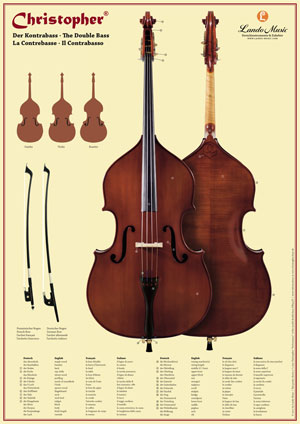 What’s a tailpiece in French? And what does the Italian mean by la tavola armonica? This double bass poster shows a beautiful Christopher violin model double bass and gives translations of the most important double bass terms in German, English, French and Italian language.
What’s a tailpiece in French? And what does the Italian mean by la tavola armonica? This double bass poster shows a beautiful Christopher violin model double bass and gives translations of the most important double bass terms in German, English, French and Italian language.
At the German Christopher website, you can order printed posters (size DIN A2 / 420 x 594 mm) for just refunding the postal charges.
Sperger Double Bass Contest
The international Johann-Matthias-Sperger-Contest for double bass will take place Sept., 29. to Oct., 5. 2008 at Ludwigslust, Germany. More infromations at www.wettbewerb.spergergesellschaft.de
Esperanza Spalding on YouTube
Wow.
Masterclasses at David Gage
David Gage String Instruments (celebrates his 30th year in the business in 2007) has announced upcoming masterclasses. The 2007-2008 Workshop Series is about to begin with two great presentations: first, the father and son duo Barre & Dave Phillips will be at Gage’s Workshop in Manhatten on Tuesday, November 27th, and then Ron Carter will present a masterclass on left-hand technique on Monday, December 3rd. These presentations will be streamed live on the internet on www.mikesmasterclasses.com.
Link tips
Double bass Luthier Georgio Pianzola from Switzerland has recetly relaunched his website www.kontrabass.ch.
Toby Chennel has published a short video on making a cornerless double bass at Youtube; Matthew Tucker from Australia shows at Youtube his DIY-bending iron in action. He’s currently working on his second bass, a cornerless model.
Christopher Double Basses now have a German website, too.
Rufus Reid video clips on jazzdoublebass.com
JazzDoubleBass.com, a new online resource for jazz double bassists with a discussion forum, articles on learning and practising and biographies of double bass giants, now has published a couple of video clips with Rufus Reid. Tom Hill talks to Rufus Reid about various topics including his bass setup, hints and tips for aspiring bass players, his new recordings and much more.
Scott LaFaro on TV
Three very short video clips featuring Scott LaFaro can be viewed at Charles A. Ralston’s website. The videos are excerpts from the April 1958 Bobby Troup ‘Stars of Jazz’ show featuring the Richie Kamuca Quintet. There’s also an interesting transkript of a rehearsal of LaFaro and Bill Evans …
” (…)
00:31 EVANS: [starts to play] Good.
LAFARO: [bows tuning his bass]
00:46 EVANS: [begins playing ‘My Foolish Heart’ solo]
02:26 LAFARO: Unbelievable, powerful, beautiful, [ then begins to accompany Evans]
03:32 EVANS: We’re now talking about
03:42 LAFARO: E-flat minor
04:00 EVANS: Yeah, . . . I think I was playing ? full type piano . . . I wish I could go a little lower on this one . . . ‘A’ might be nice.
04:12 LAFARO: I don’t know, I feel like I was playing . . .
[EVANS/LAFARO play a bit]
LAFARO: E-flat
EVANS: A-flat (…)”
Double Bass Guide Relaunch
Since I’ve put together the first version of my double bass website more than 10 years ago, the Internet and the way websites get published has changed. So I decided to turn my rather static Double Bass Guide website into a dynamic site, or more specific a so called weblog, offering the visitors advanced features like comments, RSS feeds, trackbacks, tags etc.; and me a more comfortable way to keep everything up to date. After installing WordPress to the webserver, adjusting the templates and stylesheets, putting together the category structure and feeding the database with content, I’ve finally replaced the old static pages and launched this DoubleBassGuide weblog. Please use the comment feature and let me know wheter you like it!
– Jonas
Bass Musician Magazine
The Bass Musician Magazine is a new bi-monthly virtual bass magazine. The current issue features interviews with double bassists Eric Hochberg, Christian McBride, and article on “How to Get a Good Sound When Recording With an Acoustic Bass”, and more.
Charlie Haden remembers Jimmy Blanton
“He was amazing. Duke Ellington’s band came through St. Louis and played a dance—back then it was dances and not concerts. Afterward Duke went back to the hotel to sleep, and all the musicians went to an after-hours session. This young bass player was playing, and these guys flipped out. They went back and woke up Duke Ellington, and brought him to the session. Duke hired Jimmy on the spot, and the band left St. Louis with two bass players. Jimmy Blanton made all those records in 1940 and ’41, and then he got what they called “consumption” back then, tuberculosis. He got very sick in L.A. and they had to leave him in a sanitarium. He had no family there; he was by himself in a little isolated cabin. Milt Hinton told me he went there every day to see him. Milt was playing in Cab Calloway’s band at that time, and every night they’d dedicate a song to him. Milt said he was there when Jimmy took his last breath. He was 23 years old. But if you’ve ever heard him play … man!”
